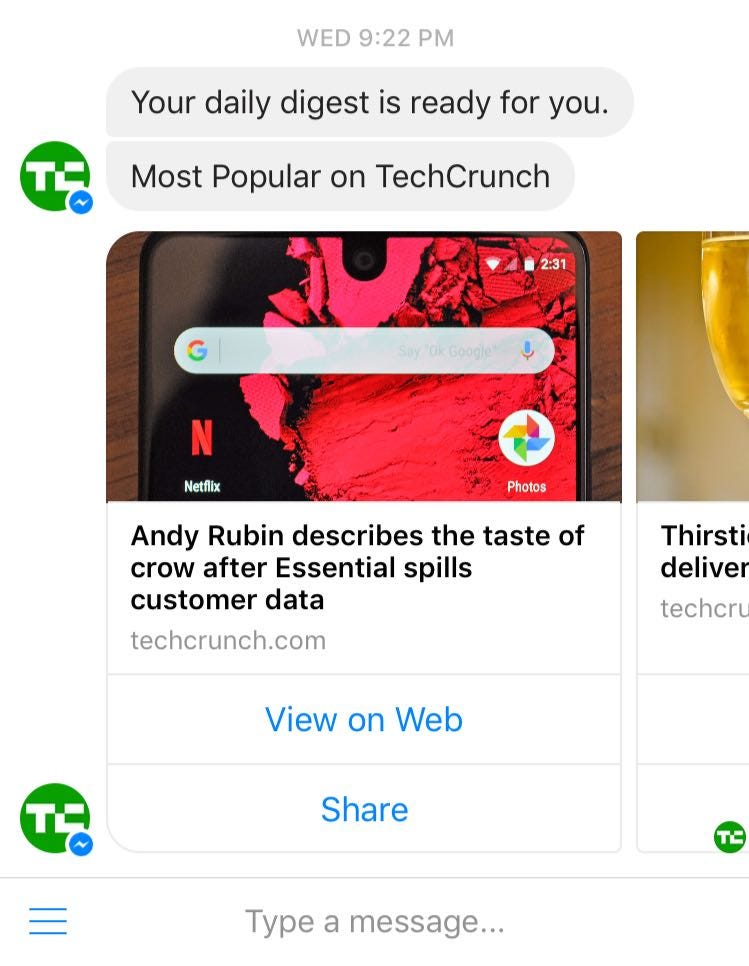Chatbots: Reality Or Hype?
Chatbots, also known simply as bots or interactive agents, are programs designed to mimic human conversation via text or audio. The implication of these programs for the music industry could be huge assuming that it isn't all just hype.
______________________
Guest post by Moses Namara of The Message
A chatbot is a computer program that is made to mimic a human in order to conduct a conversation either via audio or textual mediums. Chatbots known as bots or interactive agents can use natural language processing systems or be structured to scan for keywords in user input and respond with a matching keyword, text that is usually stored in a database with or without call to action buttons. NLP systems are largely concerned with making interactions between computers and human natural languages as seamless as possible through use of artificial intelligence.
State of the Bot.
Chatbots have become more prevalent and more apart of our daily lives after Facebook opened up their Messenger platform to outside chatbot developers to integrate their own bots in April 2016. This was in bid to get people used to the idea that they can message and interact more than just with people on Messenger. Despite the progress made so far and as more people learn about chatbots, adaptation rates remain low. Daniel Scocco in a recent 2 day July 2017 survey of 1000 respondents, found that in the United States, 69% of the respondents still prefer to interact with the customer service department of a company with a phone while 24% prefer SMS/Messaging. 70% of the participants are yet to interact with a chatbot while 73% still believe that chatbots are not useful. This is prudent enough to show that while developers and the wider chatbot community await the kill-a chatbot that will open the floodgates there is some more work to be done in getting users to comfortably, interact and consistently use chatbots. Facebook seems to have taken notice given the recent launch of a Discovery tab in the Messenger application where users can search and find bots. It has in the same faith rolled out chat extensions to enable chatbots provide interactive social features that users can invoke directly in their conversations. This is all in bid to better position chatbots more as assistants rather than conversion partners as has been the norm. In addition to these features, I believe that if developers improve on some of the following factors, there could be an increase in usability of chatbots among the masses.
Onboard Appropriately.
One of the most common problems users initaly face is how to effectively communicate and interact with chatbots. Users believe bots should be able to correctly interpret and respond to them. Therefore, they get frustrated after failing to effectively communicate with the chatbot through keywords, their own words, text and or emoji’s. Developers can aid users by ensuring that the bots they develop have preview information on what exactly they do or offer. Furthermore, to adequately onboard users and help them gain some faimiliarity using the bot, a brief walk through of the bot’s core functionality could be done. If need be, users can be directed to a web interface for comfortability with the onboarding process.
Provide Value.
A chatbot that can provide immediate and understandable value or benefit to a user will realize sustained usage and interaction. These benefits should be able to make a users daily life a bit better in furtherance for the exchange of information or continued usage.
Focus on the Core Functionality.
Chatbots with many features and others which request for user information that doesn’t necessarily add to the value and improvement of its’ core functionality turns users off. Let the core functionality of the chatbot do one thing extremely well and one thing only. As an example , I continue to be impressed by Tech Crunch chatbot which provides a daily digest of the most popular stories on Tech Crunch. It only provides the View and Share call to action button as the only necessary features to interact with the bot. This has allowed it to settle and operate subtly in my Messenger application without me feeling inconvenienced and yet keep delivering perfectly well on its core purpose.

Design for Error.
It is inherently very easy to design for situations when everything goes right than when things go wrong. As humans, we can easily correct ourselves when we error during conversations for example by asking for clarification. On the other hand, chatbots are not yet intelligent enough to even determine or even foretell the meaning of our actions in-order to automatically correct us when error occurs. It is therefore very important to understand the causes of user errors and best design to minimize those errors. Failed user actions could for example not be treated as errors but rather chatbots could be developed to be in position to use these actions as approximations to what is desired and thus try to guide users on how to correctly complete the action. If it indeed is an error, the chatbot could then admit its’ shortcoming but also have a mechanism in place to easily correct the user as compared to repeatedly displaying the same error message over and over again. This will in turn steer users on a path to properly interact with the chatbot and competently retain user engagement and attention.
With proper implementation of some of the factors above, I am optimistic that we shall start to witness further user adoption and usage of chatbots given that NLP tools continue to be developed and integrated in the messenger platform. Chatbots will become smarter and integral assistants in our daily lives where we can go for items such news and weather updates among other functionalities.
Disclaimer : The statistics figures are taken from Daniel Scocco’s recent survey and may not be taken for representative of the general population given the small sample size.